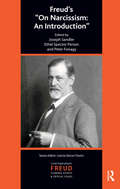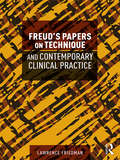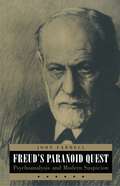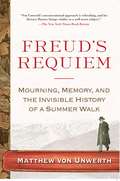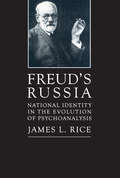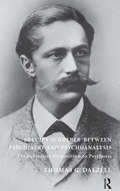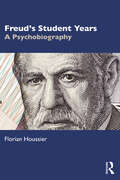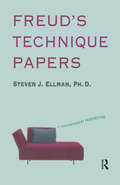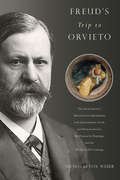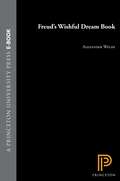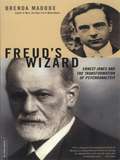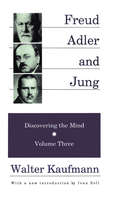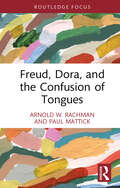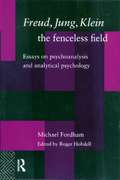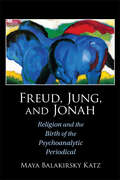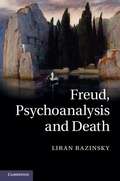- Table View
- List View
Freud's On Narcissism: An Introduction" (Ipa Contemporary Freud)
by Peter FonagyOn Narcissism: An Introduction is a densely packed essay dealing with ideas that are still being debated today - from the role of narcissism in normal and pathological development and the relationship of narcissism to homosexuality, libido, romantic love, and self-esteem to issues of therapeutic intervention. The contributors place the work in the context of Freud's evolving thinking, point out its innovations, review its problematic aspects, and examine how its theoretical concepts have been elaborated more recently by analysts of diverse theoretic persuasions. In addition, they use Freud's text to chart new developments in psychoanalysis and point toward still unresolved problems. An introduction by Joseph Sandler, Ethel Spector Person, and Peter Fonagy provides a succinct overview of the material.Contributors: Willy Baranger, David Bell, R. Horacio Etchegoyen, Peter Fonagy, Leon Grinberg, Bela Grunberger, Heinz Henseler, Otto F. Kernberg, Paul H. Ornstein, Ethel Spector Person, Joseph Sandler, Hanna Segal, Nikolaus Treurniet, Clifford Yorke
Freud's Papers on Technique and Contemporary Clinical Practice
by Lawrence FriedmanFreud’s Papers on Technique is usually treated as an assemblage of papers featuring a few dated rules of conduct that are either useful in some way, or merely customary, or bullying, arbitrary and presumptuous. Lawrence Friedman reveals Papers on Technique to be nothing of the sort. Freud’s book, he argues, is nothing less than a single, consecutive, real-time, log of Freud’s painful discovery of a unique mind-set that can be produced in patients by a certain stance of the analyst. What people refer to as "the rules", such as anonymity, neutrality and abstinence, are the lessons Freud learned from painful experience when he tried to reproduce the new, free mind-set. Friedman argues that one can see Freud making this empirical discovery gradually over the sequence of papers. He argues that we cannot understand the famous images, such the analyst-as-surgeon, or mirror, without seeing how they figure in this series of experiments. Many of the arguments in the profession turn out to be unnecessary once this is grasped. Freud’s book is not a book of rules but a description of what happens if one does one thing or another; the choice is the therapist’s, as is the choice to use them together to elicit the analytic experience. In the light of this understanding, Friedman discusses aspects of treatments that are guided by these principles, such as enactment, the frame, what lies beyond interpretation, the kind of tensions that are set up between analyst and patient, the question of special analytic love, the future of analytic technique, and a possible basis for defining Freudian psychoanalysis. Finally, he makes concrete suggestions for teaching the Papers on Technique. Freud's Papers on Technique and Contemporary Clinical Practice will appeal to all psychoanalysts and psychoanalytic psychotherapists concerned about the empirical basis of their customary procedures and the future of their craft.
Freud's Paranoid Quest: Psychoanalysis and Modern Suspicion
by John C. FarrellFreud's Paranoid Quest is an exceptionally broad-ranging and well-written book....Whether or not one agrees with certain of his arguments and assessments, one must acknowledge the remarkable intelligence that is displayed on nearly every page.--Louis Sassauthor of Madness and Modernism and The Paradoxes of Delusion John Farrell's Freud's Paranoid Quest is the most trenchant, exhilarating and illuminating book I have encountered in many years. [The book] should be pondered not just by all students of Freud's thought but by everyone who senses that 'advanced modernity' has by now outstayed its welcome.--Frederick CrewsUniversity of California, Berkeley In Freud's Paranoid Quest, John Farrell analyzes the personality and thought of Sigmund Freud in order to give insight into modernity's paranoid character and into the true nature of Freudian psychoanalysis. John Farrell's Freud is not the path-breaking psychologist he claimed to be, but the fashioner and prisoner of a total system of suspicion. The most gifted of paranoids, Freud deployed this system as a self-heroizing myth and a compelling historical ideology.
Freud's Requiem: Mourning, Memory, and the Invisible History of a Summer Walk
by Matthew Von UnwerthThis absorbing, thoughtful narrative, explores Sigmund Freud's provocative ideas on creativity and mortality and their roots in his history, while searching for broader lessons about love, memory, mourning, and creativity. Written in 1915 during winter and wartime, Freud's little-known essay On Transience records an afternoon conversation with `a young but already famous poet' and his `taciturn friend' about mortality, eternity, and the `sense' of life. In Freud's Requiem, the philosophical disagreement between Freud and his companions-who may have been the poet Rainer Maria Rilke and his muse and former lover Lou Andreas-Salome-becomes a prism through which to consider Freud's creativity as a response to his own experiences, from his passionately curious, love struck teenage years to his death after a long struggle with cancer in 1939. Drawing on a variety of literary and historical sources-Homer, Goethe, as well as Freud's own writings, including his letters-Freud's Requiem is both an intimate personal drama and a spirited intellectual inquiry. By tracing connections among Freud's ideas, his personality, and the world he lived in, Matthew von Unwerth examines the links that Freud made between art and memory. Freud's Requiem contemplates how, in mourning, we tell stories about our lives that give form and meaning to the events and feelings that threaten to overwhelm us. In recounting our stories, especially our darkest moments, we make sense of them and reclaim lost aspects of our lives, just as Freud did in his account of an afternoon walk with a poet and a taciturn companion.
Freud's Russia: National Identity in the Evolution of Psychoanalysis
by James L. RiceFreud's lifelong involvement with the Russian national character and culture is examined in James Rice's imaginative combination of history, literary analysis, and psychoanalysis. 'Freud's Russia' opens up the neglected "Eastern Front" of Freud's world--the Russian roots of his parents, colleagues, and patients. He reveals that the psychoanalyst was vitally concerned with the events in Russian history and its nineteenth-century cultural greats. Rice explores how this intense interest contributed to the evolution of psychoanalysis at every critical stage.Freud's mentor Charcot was a physician to the Tsar; his best friends in Paris were gifted Russian doctors; and some of his most valued colleagues (Max Eitingon, Moshe Wulff, Sabina Spielrein, and Lou Andreas-Salome) were also from Russia. These acquaintances intrigued Freud and precipitated his inquiry into the Russian psyche. Rice shows how Freud's major works incorporate elements, overtly and covertly, from his Russia. He describes Freud's most famous case, the Wolf-Man (Sergei Pankeev), and traces how his personality fused, in Freud's imagination, with that of Feodor Dostoevsky. Beyond this, Rice reveals the remarkable influence Dostoevsky had on Freud, surveying Freud's extensive library holdings and sources of biographical information on the Russian novelist.Initially inspired by the Freud-Jung letters that appeared in 1974, 'Freud's Russia' breaks new ground. Its fresh perspective will be of significant interest to psychoanalysts, historians of European culture, biographers of Freud, and students of Dostoevsky in comparative literature. It is a major work in fusing European intellectual history with the founding father of psychoanalysis.
Freud's Schreber Between Psychiatry and Psychoanalysis: On Subjective Disposition to Psychosis
by Thomas DalzellThis book investigates what was distinctive about the predisposition to psychosis Freud posited in Daniel Paul Schreber, a presiding judge in Saxony's highest court. It argues that Freud's 1911 Schreber text reversed the order of priority in late nineteenth-century conceptions of the disposing causes of psychosis - the objective-biological and subjective-biographical - to privilege subjective disposition to psychosis, but without returning to the paradigms of early nineteenth-century Romantic psychiatry and without obviating the legitimate claims of biological psychiatry in relation to hereditary disposition. While Schreber is the book's reference point, this is not a general treatment of Schreber, or of Freud's reading of the Schreber case. It focuses rather on what was new in Freud's thinking on the disposition to psychosis, what he learned from his psychiatrist contemporaries and what he did not, and whether or not psychoanalysts have fully received his aetiology.
Freud's Student Years: A Psychobiography
by Florian HoussierIn Freud’s Student Years, Florian Houssier presents the life experiences and inner conflicts of Sigmund Freud from his eighteenth birthday to his clinical practice, showing how these experiences informed his later theories.Following on from Freud’s Adolescence: Oedipus Complex and Parricidal Tendencies (2023) and starting at the point of the young Freud’s graduation, Houssier charts the inception of Freud’s ideas on fantasy, the Madonna-Whore complex, the Oedipal Complex, mother-daughter relationships and narcissism. Working chronologically, he looks at the way Freud’s reflection and lamentation on his inhibited adolescence led to a fantasy of possession that informed his later work. Including excerpts from Freud’s private letters to his fiancée, Martha Bernays, and exploring his relationship with Sándor Ferenczi, this volume offers a unique and intimate look into the life and inner workings of the most eminent figure of modern psychoanalysis.Accessible in style and thorough in its assessments of Freud’s personal experiences, this book is an essential read for psychoanalysts and psychologists, as well as students and scholars interested in the history of psychoanalysis and the enduring legacy of Freudian thought.
Freud's Technique Papers: A Contemporary Perspective
by Steven J. EllmanThis book focuses on how Freudian concepts have been incorporated into modern or contemporary psychoanalytic thought, introducing Freud's papers on technique and presenting his views on the place of the dream in psychoanalytic treatment.
Freud's Trip to Orvieto: The Great Doctor's Unresolved Confrontation with Antisemitism, Death, and Homoeroticism; His Passion for Paintings; and the Writer in His Footsteps
by Nicholas Fox Weber"Freud’s Trip to Orvieto is at once profound and wonderfully diverse, and as gripping as any detective story. Nicholas Fox Weber mixes psychoanalysis, art history, and the personal with an intricacy and spiritedness that Freud himself would have admired.” -John Banville, author of The Sea and The Blue Guitar"This is an ingenious and fascinating reading of Freud’s response to Signorelli’s frescoes at Orvieto. It is also a meditation on Jewish identity, and on masculinity, memory, and the power of the image. It is filled with intelligence, wit, and clear-eyed analysis not only of the paintings themselves, but how we respond to them in all their startling sexuality and invigorating beauty.” -Colm Tóibín, author of Brooklyn and Nora WebsterAfter a visit to the cathedral at Orvieto in Italy, Sigmund Freud deemed Luca Signorelli’s frescoes the greatest artwork he’d ever encountered; yet, a year later, he couldn’t recall the artist’s name. When the name came back to him, the images he had so admired vanished from his mind’s eye. This is known as the "Signorelli parapraxis” in the annals of Freudian psychoanalysis and is a famous example from Freud’s own life of his principle of repressed memory. What was at the bottom of this? There have been many theories on the subject, but Nicholas Fox Weber is the first to study the actual Signorelli frescoes for clues.What Weber finds in these extraordinary Renaissance paintings provides unexpected insight into this famously confounding incident in Freud’s biography. As he sounds the depths of Freud’s feelings surrounding his masculinity and Jewish identity, Weber is drawn back into his own past, including his memories of an adolescent obsession with a much older woman.Freud’s Trip to Orvieto is an intellectual mystery with a very personal, intimate dimension. Through rich illustrations, Weber evokes art’s singular capacity to provoke, destabilize, and enchant us, as it did Freud, and awaken our deepest memories, fears, and desires.Nicholas Fox Weber is the director of the Josef and Anni Albers Foundation and author of fourteen books, including biographies of Balthus and Le Corbusier. He has written for the New Yorker, New York Times, Los Angeles Times, Wall Street Journal, Le Monde, ARTnews, Town & Country, and Vogue, among other publications.
Freud's Wishful Dream Book
by Alexander WelshAlthough it is customary to credit Freud's self-analysis, it may be more accurate, Alexander Welsh argues, to say that psychoanalysis began when The Interpretation of Dreams was published in the last weeks of the nineteenth century. Only by going public with his theory--that dreams manifest hidden wishes--did Freud establish a position to defend and embark upon a career. That position and career have been among the most influential in this century. In August 1899, Freud wrote to Wilhelm Fliess of the dream book in terms reminiscent of Dante's Inferno. Beginning from a dark wood, this modern journey features "a concealed pass though which I lead the reader--my specimen dream with its peculiarities, details, indiscretions, bad jokes--and then suddenly the high ground and the view and the question, Which way do you wish to go now?" Physician that he is, Freud appoints himself guide rather than hero, yet the way "you" wish to go is very much his prescribed way. In Welsh's book, readers are invited on Freud's journey, to pause at each concealed pass in his seminal work and ask where the guide is taking them and why. Along the way, Welsh shows how Freud's arbitrary turnings are themselves wishful, intended to persuade by pleasing the reader and author alike; that his interest in secrets and his self-proclaimed modest ambition are products of their time; and that the book may best be read as a romance or serial comedy. "Some of the humor throughout," Welsh notes, "can only be understood as a particular kind of fine performance." Welsh offers the first critical overview of the argument in Freud's masterpiece and of the author who presents himself as guide.
Freud's Wizard: Ernest Jones and the Transformation of Psychoanalysis
by Brenda MaddoxThe saturation of the English-speaking world with psychoanalytic concepts was due largely to one brilliant analyst, Ernest Jones. As Freud’s disciple, colleague, and biographer-and the man who rescued Freud from the Nazis-he led the international psychoanalytic movement, shifting its vortex from Vienna to London and spreading its influence to Toronto, New York, and Boston. While negotiating the ferocious politics of the movement, Jones also managed an imposing series of liaisons, including an heiress and her maid, analysands, and a "Druid Bride. ” Unlike Freud, he never had to wonder, "What do women want?”
Freud, Alder, and Jung: Discovering the Mind
by Walter KaufmannWalter Kaufmann completed this, the third and final volume of his landmark trilogy, shortly before his death in 1980. The trilogy is the crowning achievement of a lifetime of study, writing, and teaching. This final volume contains Kaufmann's tribute to Sigmund Freud, the man he thought had done as much as anyone to discover and illuminate the human mind. Kaufmann's own analytical brilliance seems a fitting reflection of Freud's, and his acute commentary affords fitting company to Freud's own thought.Kaufmann traces the intellectual tradition that culminated in Freud's blending of analytic scientific thinking with humanistic insight to create "a poetic science of the mind." He argues that despite Freud's great achievement and celebrity, his work and person have often been misunderstood and unfairly maligned, the victim of poor translations and hostile critics. Kaufmann dispels some of the myths that have surrounded Freud and damaged his reputation. He takes pains to show how undogmatic, how open to discussion, and how modest Freud actually was.Kaufmann endeavors to defend Freud against the attacks of his two most prominent apostate disciples, Alfred Adler and Carl Gustav Jung. Adler is revealed as having been jealous, hostile, and an ingrate, a muddled thinker and unskilled writer, and remarkably lacking in self-understanding. Jung emerges in Kaufmann's depiction as an unattractive, petty, and envious human being, an anti-Semite, an obscure and obscurantist thinker, and, like Adler, lacking insight into himself. Freud, on the contrary, is argued to have displayed great nobility and great insight into himself and his wayward disciples in the course of their famous fallings-out.
Freud, Dora, and the Confusion of Tongues (Psychoanalytic Inquiry Book Series)
by Arnold W. Rachman Paul MattickResponding to growing interest in issues of gender and power as they arise within psychoanalysis, Freud, Dora, and the Confusion of Tongues re-examines Freud’s iconic case of Dora from the perspective of Sandor Ferenczi’s investigation of the sexual manipulation of children by adults. Freud believed that his analysis of Dora demonstrated the truth of his Oedipal theory; his treatment was based on interpretations of her statements as evidence of an unresolved Oedipal conflict. In contrast, Ferenczi’s Confusion of Tongues theory focused on the actual interactions between young people and adults who made use of their social status and power to substitute sexuality for the affection children desire. Where Freud located the origin of neurosis in psychological processes interior to the analysand, Ferenczi directed attention to the real traumatic aspects of the relationships between people. By such critical investigation, this book most strikingly shows that Freud’s imposition of his interpretations on Dora, despite his sincere wish to be of help to her, represented an abusive retraumatization. Arguing that it is essential to understand linguistic and other representational systems of experience, and the interrelation between the reproduction and transformation of self, in a contemporary analysis of Dora’s case, this book will appeal to psychoanalysts, philosophers and all those interested in a new understanding of classical psychoanalysis.
Freud, Jung, Klein - The Fenceless Field: Essays on Psychoanalysis and Analytical Psychology
by Michael FordhamA friend of Jung and Winnicott, Michael Fordham was co-editor of the collected works of Jung and the first editor of the Journal of Anaylytical Psychology. Freud, Jung, Klein - The Fenceless Field draws together his key writings on the relationship between psychoanalysis and analytical psychology.
Freud, Jung, and Jonah: Religion and the Birth of the Psychoanalytic Periodical
by Maya Balakirsky KatzReligion, more than sexuality, cast psychoanalysis in controversy and onto the world stage even as it threatened to dismantle the psychoanalytic collective. In the founding years of the first psychoanalytic periodicals, relational dynamics shaped the psychoanalytic corpus on religion. The psychoanalytic pioneers developed their ideas in tandem even if in protest to one another. Religion is a topic worthy of engagement, not least because the symbolized terrain in the history of religion was so often deployed as a vehicle for motivating, disciplining, or editing out a member of the psychoanalytic community in publication. This book offers an interdisciplinary approach to religion and psychology, including a compelling denouement that reveals new narratives about longstanding rumours in the early history of the psychoanalytic movement. Above all, this volume demonstrates that the first generation of psychoanalysts succeeded in writing themselves into the history of religious thought and sacralizing the origins of psychoanalysis.
Freud, Psychoanalysis and Death
by Liran RazinskyWas 'death' a lacuna at the heart of Sigmund Freud's work? Liran Razinsky argues that the question of death is repressed, rejected and avoided by Freud, therefore resulting in an impairment of the entire theoretical structure of psychoanalysis. Razinsky supports his claim through a series of close readings of psychoanalytic texts (including not just Freud, but Klein, Kohut, Jung and Lacan among others) that explore psychoanalysis' inattention to this fundamental human concern. The readings are combined to form an overall critique of psychoanalysis - one that remains sympathetic but calls for a rethinking of the issue of death. In presenting a fresh and persuasive interpretation of the Freudian corpus, this book will be of interest to scholars of Freud's thought and psychoanalysis, literary scholars, analysts, clinicians and to all those curious about death's psychic life.
Freud, Race, and Gender
by Sander L. GilmanA Jew in a violently anti-Semitic world, Sigmund Freud was forced to cope with racism even in the "serious" medical literature of the fin de siècle, which described Jews as inherently pathological and sexually degenerate. In this provocative book, Sander L. Gilman argues that Freud's internalizing of these images of racial difference shaped the questions of psychoanalysis. Examining a variety of scientific writings, Gilman discusses the prevailing belief that male Jews were "feminized," as stated outright by Jung and others, and concludes that Freud dealt with his anxiety about himself as a Jew by projecting it onto other cultural "inferiors"--such as women. Gilman's fresh view of the origins of psychoanalysis challenges those who separate Freud's revolutionary theories from his Jewish identity.
Freud, V. 2: Appraisals and Reappraisals
by Paul E. StepanskyVolume 2 of the Freud: Appraisals and Reappraisals series bears out the promise of the acclaimed premier volume, a volume whose essays "breathe new life into the study of Freud," embodying research that "appears to be impeccable in every case" (International Review of Psychoanalysis). It begins with Peter Homan's detailed reeexamination of the period 1906-1914 in Freud's life. Looking to Freud's relationahips with Jung as the central event of the period, he finds in Freud's idealization and subsequent de-idealization of Jung a psychological motif that gains recurrent expression in Freud's later writings and personal relationships. Richard Geha offers a provocative protrait of Freud as a "fictionalist." Anchoring his exegesis in Freud's famous case of the Wolf Man, he argues that the yield of Freud's clinical inquiries, epistemologically, is a species of the fictionalism of Friedrich Nietzsche and Hans Vaihinger. But, pursuing the argument, Geha goes on to advance little-noted biographical evidence that Freud understood himself to be an artist whose clinical productions were ultimately artistic. Finally, Patricia Herzog organizes and interprets Freud's seemingly conflicting remarks about philosophy and philosophers en route to the claim that the long-held belief that Freud was an "anti-philosopher" is a myth. In fact, she claims, "Freud was in no doubt as to the philosophical nature of his goal." In an introductory essay titled "Pathways to Freud's Identity," editor Paul E. Stepansky brings together the essays of Homans, Geha, and Herzog as complementary inquiries into Freud's putative self-understanding and, to that extent, as reconstructive, historical continuations of the self-analysis methodically begun by Freud in the late 1890s. "Each contributor," writes Stepansky, "in his or her own way, seeks to understand Freud better in the spirit in which Freud might have better understood himself. Together, the contributors offer vistas to an enlarged self-analytic sensibility."
Freud, V.1: Appraisals and Reappraisals
by Paul E. StepanskyA response to the veritable renaissance in Freud studies, Freud: Appraisals and Reappraisals presents the readers with the fruits of recent scholarship on Freud, the man and scientist, and the origins and development of the psychoanalytic movement spawned by his work. The premier volume of this series offers three major essays embodying different tributaries of contemporary Freud research. Peter Swales, drawing on extensive archival research, reveals the identity and explores the life and times of the woman Freud terms his first "teacher," but presented to his readers only as the "Frau Caecilie M" of the Studies on Hysteria. Barry Silverstein brings together complementary strands of textual analysis and psychobiographical reconstruction in his provocative reconsideration of the circumstances surrounding Freud's lost papers on metapsychology. Finally, Edwin Wallace's integrative review of Freud's scattered remarks on ethics and morality, combined with his appraisal of Freud's personal ethics, yield a measured and scholarly account of Freud as "ethicist." Briefer essays on Freud and the oral tradition (Patrick Mahony), Freud's psychology of religion (Paul Stepansky), and recent assessments of Freud's character (John Gedo) round out a volume that is destined for a place of distinction in the secondary literature on Freud. Collectively, these essays represent a most auspicious debut for the new series; they admirably bear out Paul Stepansky's intent of "presenting readers with original articles that embody high scholarship an a thought-provoking and imaginative use of the fruits of this scholarship."
Freud, the Contemporary Super-ego, and Western Morality: An Essay on Psychopolitics
by Giosuè GhisalbertiFreud, the Contemporary Super-ego, and Western Morality traces the origins of the relationship between the morality of the super-ego and the destructive impulse of the death drive in the liberal democracies of the 21st century. Giosuè Ghisalberti begins by refuting the analysis by contemporary social theorists of the phenomenon described as "the return of the religious," presenting instead a comprehensive set of ideas as outlined by Freud in the writings of the 1920s and the analysis of a contemporary theological-political unconscious. Ghisalberti argues that the psyche of the liberal West has regressed to an infantile and primitive present, driven by an unconscious hostility towards the Oedipus complex and, more comprehensively, to Western civilization as a whole. The book re-examines Freud’s psychoanalytic ideas on the nature of obsessions, interpreted first from the murder of the primal father in Totem and Taboo, and turns to his grounding ideals of intelligence, creativity, and freedom as the affirmation of the coming-to-be-human in modernity. Freud, the Contemporary Super-ego, and Western Morality will be of great interest to psychoanalysts in practice and in training. It will also be key reading for academics and scholars of psychoanalytic studies, philosophy, political theory and the humanities.
Freud, the Reluctant Philosopher
by Alfred I. TauberFreud began university intending to study both medicine and philosophy. But he was ambivalent about philosophy, regarding it as metaphysical, too limited to the conscious mind, and ignorant of empirical knowledge. Yet his private correspondence and his writings on culture and history reveal that he never forsook his original philosophical ambitions. Indeed, while Freud remained firmly committed to positivist ideals, his thought was permeated with other aspects of German philosophy. Placed in dialogue with his intellectual contemporaries, Freud appears as a reluctant philosopher who failed to recognize his own metaphysical commitments, thereby crippling the defense of his theory and misrepresenting his true achievement. Recasting Freud as an inspired humanist and reconceiving psychoanalysis as a form of moral inquiry, Alfred Tauber argues that Freudianism still offers a rich approach to self-inquiry, one that reaffirms the enduring task of philosophy and many of the abiding ethical values of Western civilization.
Freud/Lynch: Behind the Curtain
by Jamie Ruers and Stefan MarianskiThe films of David Lynch are sometimes said to be unintelligible. They confront us with strange dreamscapes populated with bizarre characters, obscure symbols and an infuriating lack of narrative consistency. Yet despite their opacity, they hold us transfixed. Lynch, who once told an interviewer, "I love dream logic," would surely agree with Sigmund Freud's famous claim that "before the problem of the creative artist, psychoanalysis must lay down its arms." But what else might the two agree on? Rather than presuming to fill in what Lynch leaves open by positing some forbidden psychosexual reality lurking behind his trademark red curtains, this book instead maintains a fidelity to the mysteries of his wonderful and strange filmic worlds, finding in them productive spaces where thought and imagination can be set to work. With contributions from scholars, psychoanalysts, cinephiles, and filmmakers, this collection of essays explores potential affinities and disjunctions between Lynch and Freud. Encompassing themes such as art, identity, architecture, fantasy, dreams, hysteria and the unconscious, Freud/Lynch takes as its point of departure the possibility that the enterprise in which these two distinct investigators are engaged might in some sense be a shared one.
Freud/Tiffany: Anna Freud, Dorothy Tiffany Burlingham and the ‘Best Possible School’
by Elizabeth Ann Danto Alexandra Steiner-StraussWith over 100 archival photographs and nine original, wide-ranging essays, Freud/Tiffany brings to life the fascinating intersection of psychoanalysis and education. Out of the cultural and political ferment of inter-war Vienna emerged the Hietzing School, founded in the 1920s by Anna Freud, the youngest daughter of Sigmund Freud, and Dorothy Tiffany Burlingham, the youngest daughter of the great American artist Louis Comfort Tiffany. Anna Freud’s story unfolds over three decades from her adolescence through the 1940s, as she and Dorothy Tiffany Burlingham leverage their hands-on research with children into educational innovations at the Hietzing School and beyond. The Viennese psychoanalysts of the 1920s demonstrated a unique sensitivity to marginalised populations and to the impact of war, its threats and its aftermath, especially on the lives of children. The book features never-before-seen historical photographs, including four of Sigmund Freud, as well as unpublished archival material and original paintings. Drawings, manuscripts and memoirs make vivid the founders’ vision of the Hietzing School’s origins, its day-to-day experience and its enduring significance for our understanding of education and the developing mind. Marking the first publication of many of the historic materials originally showcased in 2017 at a major Freud Museum London exhibition, the international scholarship behind Freud/Tiffany demonstrates that the Hietzing School remains the seedbed for a surprising range of modern theory and practice in child and adolescent mental health, from Erik Erikson’s lifespan model of 'identity' to the legal concept of 'the best interests of the child'. The Freud and Tiffany legacies are now brought together as never before in this lively book, and the Hietzing School is restored to its rightful place in the history of so many ideas with which we are still working today. The book is essential for any reader interested in the cultural legacy of interwar Vienna.
Freud: A Critical Re-evaluation of his Theories (Routledge Library Editions: Freud)
by Reuben FineIn this book, originally published in 1963, Dr Fine sets out to describe what Freud said, and to re-evaluate his views critically in the light of the best knowledge of the time. Freud’s numerous changes of view, his constant searching for the truth wherever it might lead him, as well as his resolute adherence to certain hard-won positions once he had achieved them, are all skilfully traced. Freud’s intellectual Odyssey is divided into four periods. From 1886 to 1895 he was a neurologist investigating hysteria and other ‘nervous’ disorders. Then came his self-analysis, from 1896 to 1899, the real matrix from which psycho-analysis grew. The first psycho-analytic system of psychology was developed in the period from 1900 to 1914. The remainder of his life, from 1914 to 1939, was devoted to the elaboration of ego psychology, and heart of contemporary psycho-analysis. Dr Fine undertook, in writing this book, the formidable task of examining the whole body of Freud’s thought, to clarify what he said, and to review his ideas critically in the light of the best available existing knowledge. As he says ‘In this process of criticism I have tried to specify which aspects of Freud have stood the test of time and which have not.’ ‘So far as I can see no one has ever before taken the trouble to ask: "What did Freud actually say? How does what Freud said stand up in terms of what we now know?"’ In answering these questions, Dr Fine develops a major thesis that all modern psycho-analysis derives from Freud, though it has moved far in many different directions. The contention is that emphasis on schools is misleading and has obscured the actual historical growth of the science. As he states in his Preface to this volume, Dr Fine’s conviction is: ‘By building on Freud’s fundamental insights, we can move on most readily to empirical research and thus construct a more satisfactory science of psychology.’
Freud: A Life For Our Time
by Peter GayNorton celebrates the 150th anniversary of Freud's birth by reissuing Peter Gay's best-selling biography, featuring a new introduction.
